A Highly Competitive Weed With A Soft Touch
DR. MANDY BISH AND DR. KEVIN BRADLEY
COLUMBIA, MO.
Velvetleaf is an erect, summer annual that is easily identifiable by the heart-shaped leaves and soft hairs, which cover the weed. This plant was introduced and cultivated in the U.S. in the 18th century as a source of fiber1 and is now a weed present in the 48 contiguous states and categorized as noxious in 4 of those2. It is a highly competitive weed with allelopathic properties and thus has become a problematic pest of row crop systems (Figure 1). Published studies have shown that when velvetleaf emerges at the same time as soybean at a density of 1 plant per foot of soybean row, the soybean yield can be reduced from 14 to 27 percent. (Velvetleaf tends to be more competitive with the crop during days with shorter daylight hours. Because of this, if soybean and velvetleaf emerge together in early May, there is a greater potential for yield loss. When soybean planting is delayed to late May or early June, 1 velvetleaf plant emerging per foot of soybean row will cause approximately 14 percent yield loss 3.)
Velvetleaf seedlings can be confused with prickly sida, which begins to emerge at the same time and has 2 heart-shaped cotyledons.
Velvetleaf seedlings have one heart-shaped cotyledon and one round cotyledon (Figure 2). The cotyledons and the stem below the cotyledons (hypocotyl) are covered with soft, short hairs.
The leaves of velvetleaf are heart-shaped, covered with hairs on both the upper and lower surfaces, have toothed margins, and grow to 2 to 6” long and wide. The main veins on the leaves are clearly visible (Figure 3). The stem of velvetleaf can reach 7 feet in height, is mostly unbranched, and is also covered with soft hairs. Both the leaves and stem emit an unpleasant odor when crushed. The root consists of a taproot with an extensive system of fibrous roots that branch from that main root.
Velvetleaf flowers are approximately ½ to 1” wide and consist of 5 orange-yellow petals (Figure 4). Each plant can produce up to 8,000 seeds, which are kidney-shaped, covered in hair, grayish brown to brownish black in color, and approximately 1/8” square (Figure 5). The seed will remain dormant until the following spring. However, studies have indicated that the seed can remain dormant and viable for up to 60 years making velvetleaf particularly difficult to eradicate once present.
Pre-emergent herbicides are most effective in controlling velvetleaf and allowing the crop to gain the competitive advantage. Most 2- or 3-way pre-packaged combination products that contain atrazine, Corvus, Callisto, Hornet, and Python provide good PRE control in corn. It is also noteworthy that velvetleaf with resistance to atrazine has been confirmed in four states, but we are not aware of any in Missouri. In soybean, most of the Authority products, Canopy, Envive, Fierce, Fierce XLT, Firstrate, Gangster, Pursuit, Python, Sencor, Sharpen, Trivence, and Valor XLT are all effective PRE herbicides for velvetleaf. Cultivation may also help with preventing emergence. The optimal soil depth for velvetleaf seed germination and emergence is 1 inch; however, emergence rate is reduced by 50 percent for every inch that the seed is buried below that depth.
Studies have suggested that velvetleaf plants that emerge 3 weeks or more after soybean emergence contribute little to soybean yield loss as the soybeans are usually large enough to shade out velvetleaf seedlings. However, POST applications can prevent velvetleaf plants from going to seed. In corn, there are a variety of effective POST options. Some of the more common include products that contain 2,4-D, dicamba, atrazine, and mesotrione, although there are others. Aim, Cadet, FirstRate, Pursuit, Resource, Liberty, and glyphosate products are effective POST options in soybean. To see a more comprehensive list of chemical control options view our Pest Management Guide (M171) here: http://weedscience.missouri.edu/publications/m00171.pdf.
Because velvetleaf leaves droop extensively from late evening until early morning, the most effective herbicide applications will occur during the middle portion of the day when the maximum amount of velvetleaf surface area will come into contact with the herbicide.
To read more about velveltleaf or check out other common Missouri weeds, visit our Web site: weedid.missouri.edu
1Spencer NR. (1984) Economic Botany 38(4): 407-416.
2USDA Plants Database: plants.usda.gov
3Oliver LR. (1979) Weed Science 27(2): 183-188. ∆
DR. MANDY BISH: Division of Plant Sciences, University of Missouri
DR. KEVIN BRADLEY: Division of Plant Sciences, University of Missouri
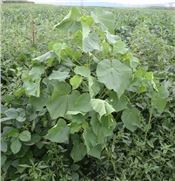
Figure 1. : A velvetleaf plant outcompetes the neighboring soybean plants.
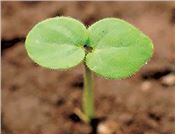
Figure 2. Velvetleaf seedlings have 1 round cotyledon, such as the one on the left, and one heart-shaped cotyledon, like the one on the right.
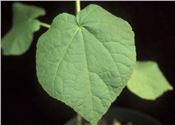
Figure 3. Each leaf of velvetleaf grows 2 to 6" both long and wide, is covered with hairs, and has visible main veins.
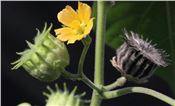
Figure 4. The velvetleaf flower is comprised of 5 orange to yellow petals. Two seed pods, a green immature pod and a black, mature pod, can also be seen in this image.
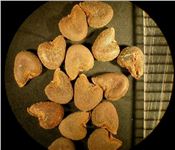
Figure 5. The distinct seeds of velvetleaf are kidney-shaped and covered in hairs.